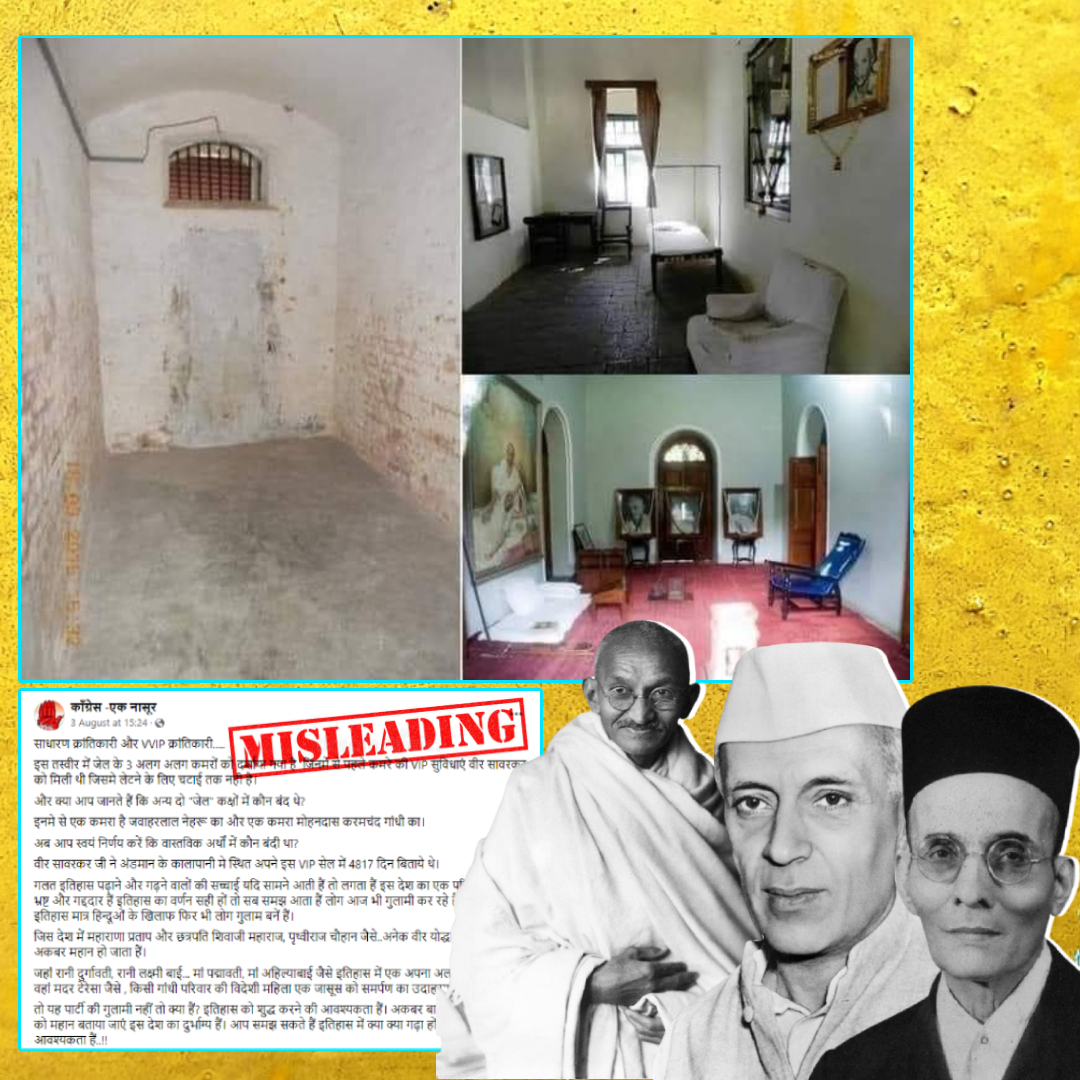
Image Credit: Twitter, VD Savarkar/Wikibio, Mahatama Gandhi/Wikipedia, Jawahar Lal Nehru/Wikipedia
These Images Show Misleading Comparison Between Cells Of Nehru, Gandhi And Savarkar
Writer: Jakir Hassan
A journalist at heart loves the in-depth work of reporting, writing, editing, research, and data analysis. A digital and social media enthusiast.
India, 24 Aug 2022 12:40 PM GMT
Editor : Bharat Nayak |
As the founding editor, Bharat had been heading the newsroom during the formation years of the organization and worked towards editorial policies, conceptualizing and designing campaign strategies and collaborations. He believes that through the use of digital media, one could engage the millennial's in rational conversations about pertinent social issues, provoking them to think and bring a behavioral change accordingly.
Creatives : Jakir Hassan
A journalist at heart loves the in-depth work of reporting, writing, editing, research, and data analysis. A digital and social media enthusiast.
Netizens claimed that Savarkar was treated worse by the British government, whereas Nehru and Gandhi were awarded comparatively luxurious places of imprisonment. The Logical Indian fact check team verified the viral claim.
A set of images showing an alleged comparison of the prison cells of V.D. Savarkar, Mahatma Gandhi, and Jawaharlal Nehru is being spread. It is being circulated in context of row occurring in Karnataka after violence over posters of Savarkar and Tipu Sultan in Shivamogga on August 15.
Claim:
The image shows a collage of three rooms, out of which a room is sparse with no rooms and a singular source of light. The other two rooms have several pieces of furniture, a chair, a sofa and a drawer can be seen in the rooms. Netizens claimed that Savarkar was treated badly by the British government, whereas Nehru and Gandhi were awarded comparatively luxurious places of imprisonment.
"Ordinary Revolutionary versus VVIP Revolutionary. Three different jail rooms have been shown, in the first room, which was given to Veer Savarkar, where there is not even a mat to lie down. Do you know who was lodged in the other two jail cells? One room belongs to Nehru and one to Gandhi. Now you decide for yourself who was the prisoner?"
The post is viral across Facebook and Twitter with the same claim.
Fact Check:
The Logical Indian fact check team verified the viral claim and found it to be misleading.
We isolated the collage into three separate images and conducted a reverse image search on the images. We found the context behind the images and the imprisonment of the historical leaders.
V. D. Savarkar:
First, we conducted a keyword search to understand how and why V.D. Savarkar was convicted.
In March 1910, V.D. Savarkar was arrested following the Nashik Conspiracy Case and later convicted. On December 21, 1909, Anant Laxman Kanhere, a member of the Abhinav Bharat Society, shot Nashik Collector A. M. T. Jackson in the theatre. This case is known as Nasik Conspiracy Case. V.D. Savarkar, his brother Ganesh Savarkar, and other members of the Abhinav Bharat Society were found guilty and was convicted. He was shifted to the Cellular Jail in Port Blair on 24 February 1911, says Britannica biography of Savarkar.
In a second trial, he was convicted of his involvement in the assassination of AMT Jackson, a British district magistrate in India. After sentencing, he was transported to the Andaman Islands to serve his detention "for life." He was brought back to Ratnagiri in India in 1921 and released from detention in 1924.
We then conducted a reverse image search for the part of the image showing the room with no furniture. We came across the following image uploaded on Alamy.
In the description, it is written, "Port Blair, Andaman Islands. India. January 12, 2018: freedom fighter Vinayak Savarkar was imprisoned in this cell by the British at Cellular Jail in Port Blair, Andaman, India."
We also came across another image of the same room on Wiki Commons.
Jawaharlal Nehru:
Nehru was jailed for his leadership role in the Quit India movement in 1942. He was jailed for nearly three years in Ahmednagar Fort, according to the Indian Culture, Government of India website.
As per details on the official website of the Prime Ministers of India, Nehru's imprisonment at Ahmednagar Fort was his longest and also his last detention. His imprisonment at the Ahmednagar Fort Prison was between 09 August 1942 and 15 June 1945. In all, he was imprisoned nine times in jails such as the Central Jail, Lucknow Jail, Allahabad District Jails along with Naini, Gorakhpur, and Bareilly Jail.
After conducting a reverse image search on the 2nd image, we came across the same image uploaded to Alamy with the caption, "the freedom fighters jailed in Ahmednagar Fort."
We also came across a Lallantop article published on 27 May 2020. This article provided details of Nehru's imprisonment and where he was mandated to carry out his sentence.
M.K. Gandhi:
Gandhi was arrested for the first time on April 10, 1919, in India. Following this, he was arrested ten times from 1922 to 1944. In 1942, he was arrested for his leadership of the Quit India movement and was detained at Aga Khan Palace in Pune.
The website the Gandhi Heritage report states that Gandhi was imprisoned in Dandi, Palwal, and Bombay Jails, whereas he was imprisoned multiple times at the Yervada Jail.
We conducted a reverse image search on the third image in the collage. We came across the same viral image on Wikipedia Commons titled, 'Gandhiji's Room in Aga Khan Palace'.
Conclusion :
In our Fact Check, we found that Savarkar, Nehru and Gandhi, all these historical leaders went to jail, and the rooms of Gandhi and Nehru weren't uniformly pleasant as the viral post claims. And, the charges on which they were arrested differs. The British government arrested Jawaharlal Nehru and detained Mahatma Gandhi to weaken the Quit India Movement and other freedom-related movements. In contrast, Savarkar was arrested in the Nashik Conspiracy Case in 1910. Savarkar, his brother and other members of the Abhinav Bharat Society were also found guilty of Murdering Nashik Collector A. M. T. Jackson. Probable murdering an officer was the reason he was sent to the Andaman Islands (Kala Paani) to serve his detention "for life." Thus, the missing context of the incidents and comparison makes the posts misleading.
If you have any news that you believe needs to be fact-checked, please email us at factcheck@thelogicalindian.com or WhatsApp at 6364000343.
Also Read: No, The BJP Govt Has Not Completely Privatised All These Central Public Sector Enterprises
 All section
All section














